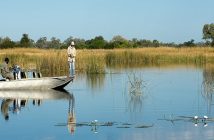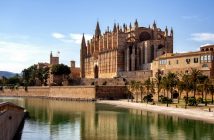A damp and grey winter’s day and I am visiting Lacock, this tiny and unique village, three miles from Chippenham in Wiltshire. The M4 speeds motorists between London and Bristol a few miles north, but to come to Lacock is to escape and take a trip back in time.
It’s quiet, peaceful and a world away from day-to-day issues. A mist is hanging over the ancient headstones in the churchyard as I walk past and seems to infuse the atmosphere with rather ghostly thoughts. Turning into the main street – one of only four here – such illusory senses readily take me back to the rustic days of 18th century England as I see before me a wide thoroughfare lined, on both sides, with ancient stone cottages, quaint shop fronts and historic coaching inns.
One has only to visually blot out today’s modern forms of transport parked along the street and conjure up in a mind’s eye the sight of the wagons, pony traps and broughams that used to ply the street. It’s easy to imagine market days here with local produce, pedlars, animals and various forms of poultry characterising earlier lives. This is old village life, virtually untouched, epitomises the setting of country living in the 1700s and 1800s. It is with good reason that the village has been the very picturesque film and television set for the dramatic productions of Jane Austen’s ‘Pride and Prejudice’ (BBC 1995) and of Mrs Gaskell’s ‘Cranford’ (BBC 2007). Both novels whose tales of contemporary behaviour and manners in the 1800s have left behind a rich legacy of English social life and have been so beautifully brought to life in the setting of Lacock.

The Domesday Book mentions Lacock as having a population between 160 and 190. Today, some 900 years later, an approximate 2000 people live here and, it would seem, are happy to maintain the various stipulations that help to preserve the village. Lacock is almost entirely owned and managed by the National Trust – those guardians of our historic and cultural sites, and thank goodness for them. I believe permission must be sought for any extensions, building developments and outer decoration or adornment all, of course ,with the intent to maintain the village in the glorious state visitors find it today.
The architecture here combines, effortlessly it seems, houses, cottages, tithe barns, church and abbey with a wonderful blend of stone, brick and timber – some dating back to the 13th century, and many with medieval and monastic connections. A stroll around the village reveals the 14th century tithe barn – a vast timbered barn arising from an earthen floor – this is where villagers came to pay their rents in kind; fleeces, hides and corn were collected and stored here. Nearby is St. Cyriac’s Church – of largely 15th century construction but some earlier features within, and its tower dating to the 16th century. A 1501 brass in the south transept is dedicated to one Robert Baynard, his wife, five sons and thirteen daughters and illustrates how such large families were typical of the age. A wish and need to ensure that at least some would survive the rigours of the times.

Lacock Abbey lies rather distant from the main street – not in a physical sense, it is but a five minute walk – but its serene setting, behind tall gates, in the wonderfully-named Snaylesmeade meadows alongside the River Avon, set it apart from the rest of the village. Built as a nunnery in 1232 the building was acquired, after the Reformation, by Sir William Sharington who converted it into a Tudor mansion and added a brewery. This still stands today and one can see the ancient mash tun, cooling trough and fermenting vat in the Abbey courtyard. The original Abbey cloisters were, thankfully, left intact along with other medieval features. Sir William died in 1553 and is buried in a remarkably ornate Renaissance tomb within St. Cyriac’s Church. The Abbey passed to his brother Henry, who entertained Queen Elizabeth I here, and then to his daughter who had married into the Talbot family of Worcestershire.
Today, the Abbey contains a very well set out museum depicting the life and work of William Henry Fox Talbot – largely acknowledged as the pioneer of photography in the 1830s. Somewhat in competition with the daguerreotype being developed in France, Talbot’s important contribution was the negative, enabling further positive images to be produced. It is believed, but not confirmed, that a photograph of the Abbey’s oriel window was the first photograph ever taken. In 1944 the property was given to the National Trust and their tenants today are still descendants of the Talbot family.
Returning to the main street I feel it is time to call into one of the lovely old inns here for some refreshment. En route, past the pretty gardens of these lovely houses and cottages, it is noticeable that many of the larger houses contain open passages to their sides. These were to enable horses to be led from the street to their stabling at the back. Some of the first floor windows are wider than others and I find that this was to allow the extra accommodation required for the broad loom – introduced in the 15th century and a necessary tool for the growing wool industry here.

Enjoying a drink next to a roaring fire in The Red Lion (a 1740 facade but concealing a far older building), the manager tells me that this particular inn was where the local hunt would meet outside on Boxing Days. We both look past the hunting debate and prefer to recall, instead, the sight and sound of some 30 horses standing outside on a crisp winter’s morning, air and sweat steaming from their bodies, whilst their riders, encased in red jackets, partook of a sherry before galloping off across the countryside in pursuit of Mr Reynard.
Lacock in winter has been a wonderful experience. Obviously it is quieter than in the summer months when tourists and visitors stroll the streets, discover the tearooms and the tiny shops, and fill the church and the Abbey with their interest and enthusiasm. Snaylesmeade meadow is awash then with its long grasses, poppies, cornflowers and columbines, while the swallows swoop around looking for nesting sites amongst these ancient buildings.
One can come here just to look and enjoy the setting, the architecture and the nature without much thought. Look and think a little deeper, however, and you will find that you have been privy to an England as it was lived all those years ago. A treasure indeed.
For more information about Lacock, visit the National Trust website.




